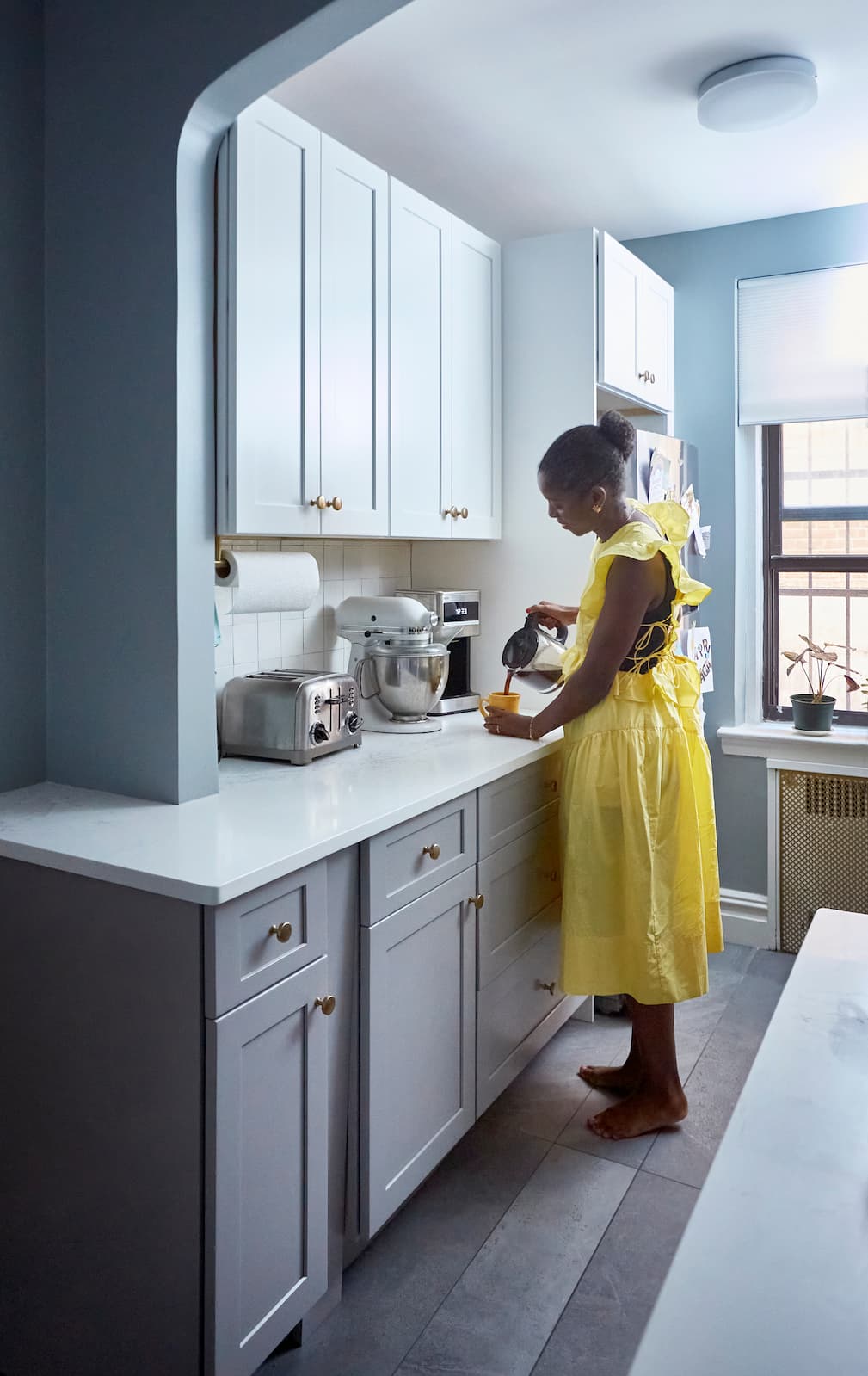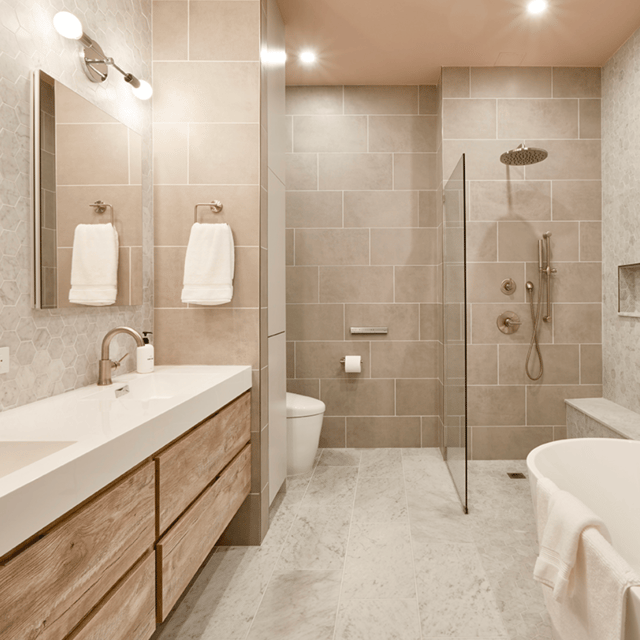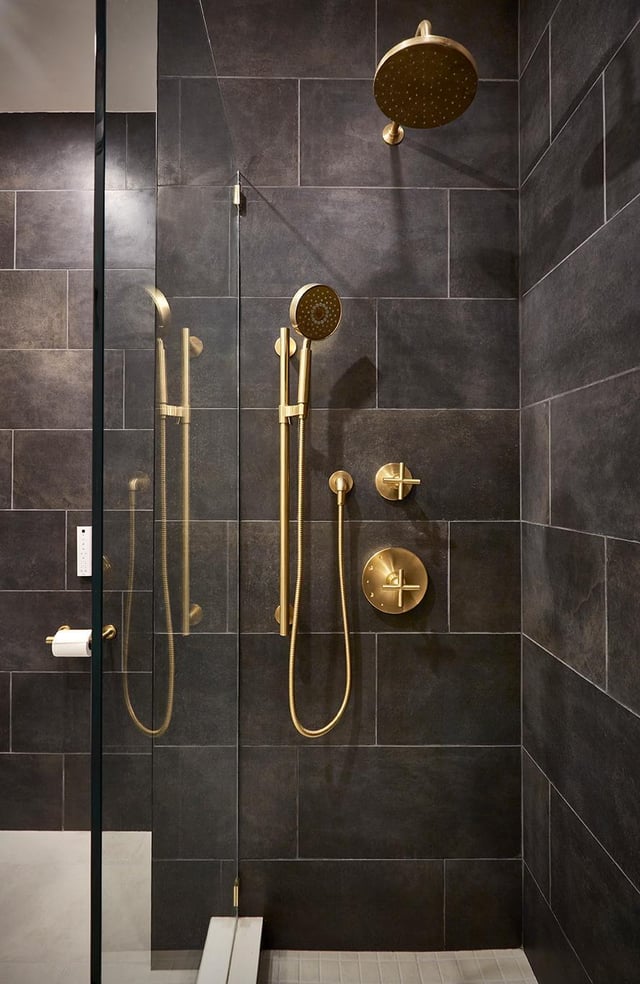
Bathroom
Eco-Friendly Shower & Bathroom Ideas
12.23.2025
Our New Year savings event is here: Get up to $6,500 off your project today (terms apply).


In This Article
When you’re working with a small bathroom, every design decision matters, especially your choice of flooring. The right bathroom floor can make your space feel larger, brighter, and more inviting, while also standing up to daily wear and moisture.
But great style is only part of the equation. Longevity, safety, and ease of maintenance are just as important when selecting materials that will serve you well for years to come. Whether you’re searching for inspiration or ready to start your remodel, these bathroom flooring ideas will help you create a space that’s both beautiful and built to last.
Choosing the right material is the foundation of any successful bathroom remodel. Each flooring type offers unique benefits and considerations, especially in a space that faces daily moisture and heavy use.
Porcelain and ceramic tiles are classic choices for bathroom floors, offering a wide range of colors, patterns, and finishes. They’re durable, water-resistant, and easy to clean, making them a go-to for both large and small bathrooms. Their hard surface stands up well to daily wear and tear, and they can last for decades with proper care.
Primary advantages of porcelain/ceramic tile: Porcelain or ceramic tile offers exceptional water resistance and design versatility, making it suitable for virtually any bathroom style.
Disadvantage of porcelain/ceramic tile: These tiles can feel cold and hard underfoot, especially in cooler climates, unless you install radiant heating.
Natural stone, such as marble, slate, or travertine, brings a luxurious, organic feel to any bathroom. Each tile is unique, adding subtle texture and depth to your floor. Stone floors are highly durable and can increase the value of your home, but they do require a bit more care.
Primary advantage of natural stone: This type of bathroom floor brings quiet beauty and one-of-a-kind character, which can elevate the look of any bathroom.
Disadvantages of natural stone: Natural stone requires regular sealing and maintenance, and it can be more expensive than other flooring options.
Luxury vinyl tile mimics the look of natural materials like wood or stone, but with added resilience and comfort. It’s waterproof, budget-friendly, and softer underfoot than tile or stone. LVT is also easy to install and replace, making it a smart idea for busy households.
Primary advantages of LVT: Luxury vinyl tile is affordable, waterproof, and comfortable to walk on, making it ideal for family bathrooms.
Disadvantage of LVT: The primary disadvantage of luxury vinyl tile is that it may not have the same high-end feel or long-term durability as real stone or tile.
Learn more about Luxury Vinyl Tile as a bathroom floor option in this guide.
Engineered wood offers the warmth and beauty of hardwood, but with better moisture resistance thanks to its layered construction. It’s a stylish option for bathrooms where you want a cozy, natural look. However, it still requires careful installation to prevent water damage.
Primary advantage of engineered wood: This floor material is celebrated for the warmth and elegance it brings to a small bathroom, creating a welcoming atmosphere.
Disadvantage of engineered wood: Unfortunately, even when engineered, wood remains sensitive to standing water and may not be as durable as tile or stone in wet environments.
Concrete floors are modern, durable, and can be finished in a variety of textures and colors. They’re a great fit for contemporary or industrial-style bathrooms. With proper sealing, concrete can resist moisture and stains, but it does require some maintenance.
Primary advantage of concrete: Concrete is highly durable and customizable in appearance, allowing for a truly unique bathroom floor.
Disadvantage of concrete: The primary disadvantage of concrete for bathroom flooring is that it can feel cold and hard underfoot, and may require periodic sealing to maintain its look.
Bring Your Dream Bathroom to Life

Marble floors bring timeless elegance and natural beauty to any bathroom, instantly elevating the space. Each marble tile features unique veining and subtle color variations, creating a luxurious, one-of-a-kind look. While marble is naturally cool and smooth underfoot, it does require sealing and regular care to protect against moisture and stains.
Primary advantage of marble: Marble offers unmatched sophistication and visual appeal, making your bathroom feel both refined and unique.
Sheet vinyl is a practical, budget-friendly choice that’s easy to install and maintain. It comes in a wide range of patterns, including realistic stone and tile looks. Its seamless installation makes it especially effective at keeping water out.
Primary advantages of sheet vinyl: Sheet vinyl is seamless, waterproof, and cost-effective.
Disadvantages of sheet vinyl: Sheet vinyl is less durable than tile or stone and can be difficult to repair if damaged.
Cork flooring is a natural, eco-friendly remodeling option that brings warmth and comfort to any bathroom. Its soft, cushioned surface feels pleasant underfoot and provides natural insulation, helping to keep your bathroom cozy year-round. Cork is also naturally resistant to mold, mildew, and bacteria, making it a healthy choice for humid environments.
Primary advantage of cork: Cork offers a soft, warm, and comfortable surface that is gentle on feet and joints, while also being a sustainable and renewable material.
Disadvantages of cork: Cork is susceptible to water damage if not properly sealed and maintained, so it requires diligent sealing and care to ensure long-term durability in a bathroom setting.
Recycled glass tile is a striking, eco-conscious flooring choice that adds color, light, and personality to your bathroom. These tiles are made from post-consumer or post-industrial glass, offering a sustainable way to create a unique, reflective surface. Recycled glass tiles are non-porous, making them resistant to stains, mold, and mildew, and they’re available in a wide range of colors and patterns.
Primary advantages of recycled glass tile: Recycled glass tile is environmentally friendly, highly resistant to moisture, and reflects light beautifully, making small bathrooms feel brighter and more open.
Disadvantages of recycled glass tile: Recycled glass tile can be slippery when wet and may require textured finishes or careful placement to ensure safety, especially on bathroom floors.
River rock, or pebble tile, brings a natural, spa-like feel to your bathroom floor with its organic shapes and soothing textures. Each pebble is unique, creating a one-of-a-kind surface that gently massages your feet and adds visual interest. Pebble tile is often used in shower floors or as an accent, but it can also be installed throughout the bathroom for a cohesive, nature-inspired look.
Primary advantage of river rock: River rock tile provides a unique, tactile experience and a relaxing, natural aesthetic that transforms your bathroom into a tranquil retreat.
Disadvantages of river rock: River rock tile requires careful installation and regular sealing to prevent water infiltration and maintain comfort, and the uneven surface can be harder to clean than flat tiles.
Perfect Every Detail of Your Bathroom

Large-format tiles are a wise pick for small bathrooms because they visually expand the space. With fewer grout lines breaking up the floor, the room feels less busy and more open, creating a seamless look that tricks the eye into perceiving a larger area.
As a bonus, large tiles are also easier to clean, as there are fewer grout lines to maintain, making them both a practical and stylish idea for compact bathrooms.

Choosing grout that closely matches your tile color is a subtle but powerful way to make a small bathroom feel bigger. When grout lines blend in rather than stand out, the floor appears more continuous and less segmented, which helps the space feel unified and calm.
This technique is particularly effective with simple, monochromatic tiles, as it creates a smooth, uninterrupted surface. Subtle grout lines also lend a modern, sophisticated look to your bathroom, making it feel thoughtfully designed and easy to maintain.
 Let this New York bathroom inspire your floor designs
Let this New York bathroom inspire your floor designs
Carrying the same tile from the bathroom floor up onto the shower walls is a designer idea that instantly makes a small bathroom feel more expansive. This creates an uninterrupted visual flow, drawing the eye upward and around the room.
By minimizing material changes, you reduce visual clutter and give the space a cohesive, spa-like feel. This approach also simplifies cleaning and maintenance, as you’re working with a single material throughout the room.
 Check out this New York bathroom rich with stone
Check out this New York bathroom rich with stone
Light-colored flooring is a tried-and-true idea for making a small bathroom feel larger and more open. Pale tiles or light wood tones reflect natural and artificial light, instantly brightening the space and creating an airy, welcoming atmosphere.
This is especially effective in bathrooms with limited windows or natural light, as it helps maximize every bit of brightness. Pairing light floors with similarly toned walls and fixtures can create a serene, cohesive look that feels both modern and timeless.
 View this gold-accented bathroom
View this gold-accented bathroom
Natural stone tiles with gentle veining or soft color variations add depth and interest to a small bathroom without overwhelming it. These organic patterns bring a sense of luxury and uniqueness, as no two tiles are exactly alike. Subtle variances help disguise water spots and daily wear, making your bathroom floor both beautiful and practical.
 View these beautiful marble floors
View these beautiful marble floors
Introducing contrasting colors on your bathroom floor can add energy and definition to a small space. A bold floor can serve as a focal point, drawing attention and anchoring the room, while also helping to define different zones within the bathroom. Contrasting tiles can be used to highlight architectural features or create a sense of movement and interest.
To keep the look balanced, pair bold floors with more neutral walls and fixtures, ensuring the space feels dynamic but not overwhelming.
 Let this Brooklyn bathroom inspire your bathroom floor ideas
Let this Brooklyn bathroom inspire your bathroom floor ideas
Patterned tiles, whether geometric, encaustic, or inspired by classic motifs, bring personality and style to even the smallest bathrooms. Bold patterns can make a statement and turn your floor into a work of art, providing visual interest and a sense of playfulness. When using bold patterns, it’s a smart idea to keep the rest of your palette simple, allowing the floor to take center stage without making the room feel chaotic.
This approach is ideal for homeowners who want to express their creativity and make their bathroom truly one-of-a-kind.
 See how this New York bathroom features bold floors
See how this New York bathroom features bold floors
A well-installed waterproof membrane beneath your flooring is essential for protecting your bathroom from leaks and water damage. This step is especially important in small bathrooms, where water can easily reach every corner and cause long-term issues if not properly managed.
Investing in quality waterproofing not only extends the life of your flooring but also protects your home’s structure.
Don’t skip this step. It’s the foundation for a worry-free bathroom remodel.
Know the Cost Before You Start

Radiant floor heating adds a touch of luxury and comfort, making tile or stone floors warm underfoot, even on chilly mornings. Heated floors are energy-efficient and can help reduce humidity, which is especially beneficial in small, enclosed bathrooms.
This upgrade can also increase your home’s value and make your bathroom feel like a spa retreat. If you’re already replacing your flooring, this cozy addition is the perfect idea.
Safety is key in any bathroom, but it’s especially important in small spaces where slips and falls can happen easily. Look for tiles with a matte or textured finish to help prevent accidents, particularly in wet areas like the shower or near the sink. Many manufacturers offer slip-resistant options specifically designed for bathrooms.
Prioritizing safety doesn’t mean sacrificing style. There are plenty of beautiful, slip-resistant tiles to choose from.
Don't Forget About Maintenance
Select flooring that fits your lifestyle and maintenance preferences. Some materials, like natural stone, require regular sealing and special cleaning products, while others, like vinyl or porcelain tile, are much easier to care for. Consider how much time you’re willing to spend on upkeep before making your final decision. Choosing a low-maintenance option can save you time and effort in the long run, keeping your bathroom looking fresh and beautiful.
Turn your renovation vision into reality
Get matched with trusted contractors and start your renovation today!
Find a Contractor
Choosing the right bathroom flooring is just the beginning of your renovation journey. The real difference comes from working with a contractor who understands your vision and delivers quality craftsmanship.
At Block, we specialize in connecting homeowners with thoroughly vetted, reliable contractors who are the right fit for your project. From inspiration to installation, our team is here to support you every step of the way, so you can move forward with confidence and peace of mind.
Explore our gallery of real bathroom transformations, use our free Renovation Studio, or connect with a Project Planner to find the perfect contractor for your remodel.

Written by Block Renovation

Renovate confidently with Block
Easily compare quotes from top quality contractors, and get peace of mind with warranty & price protections.
Thousands of homeowners have renovated with Block

4.5 Stars (100+)

4.7 Stars (100+)

4.5 Stars (75+)

Bathroom
Eco-Friendly Shower & Bathroom Ideas
12.23.2025

Bathroom
New York City Bathroom Remodels: Planning & Renovation Tips
12.05.2025

Bathroom
Slanted Roof Bathrooms and Shower Design Ideas
11.22.2025

Bathroom
Choosing Bathroom Fixture Finishes - Inspiration & FAQ
10.22.2025

Bathroom
Designing a 40-Square Foot Bathroom? Here’s What Actually Matters
10.22.2025
Renovate confidently